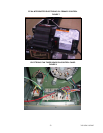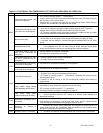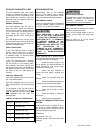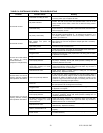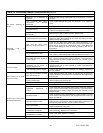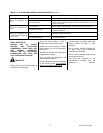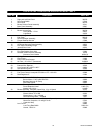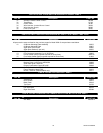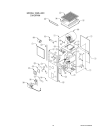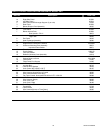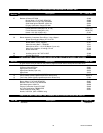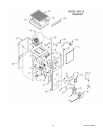
30318 R4 9/9/2005
30
TABLE C-4: SYSTEM AND GENERAL TROUBLESHOOTING continued
Problem Possible Cause Remedy
Electrodes out of adjustment or
defective.
Check electrode settings. Check electrodes for dirt build-up or cracks in
porcelain.
Poor transformer high voltage
connections or defective
transformer.
Check contacts between the igniter and electrodes. If OK, replace the
igniter
Fuel oil filter clogged. Replace fuel oil storage tank filter and / or fuel oil in-line filter.
Defective oil pump.
Check burner motor / fuel oil pump coupling. Check oil pump pressure.
Replace fuel oil pump if necessary.
Oil burner sputtering at
nozzle
Fuel oil line partially clogged or
contains air.
Bleed air from oil line. If problem persists, replace oil line.
System temperature rise too high.
System temperature rise ideally should not exceed 85°F. Check for
clogged air filters. Check blower fan for excess dirt build-up or debris.
Speed up blower fan if necessary.
Poor “fan off” delay timing
selection, (fan stops too soon).
Check “fan off” delay timing setting. Use a duct thermometer in the
supply air plenum take-off or first few inches of the supply air trunk duct.
Ideally, the fan will shut off at a temperature of 90° - 100°F. Manipulate
the dip switch settings to come as close as possible to this “fan off”
temperature.
Fuel oil leak. Check fuel oil line for leaks. Repair or replace if necessary.
Stack temperature too high.
Check stack temperature. Stack temperatures will normally range from
350° to 450°F. Check draft regulator. Draft should be set to 0.02 in. w.c.
Excessive fuel oil
consumption.
Thermostat improperly adjusted or
in poor location.
Check thermostat heat anticipator setting against measured amperage
draw. Increase heat anticipator setting if necessary. If the thermostat is
being influenced by drafts, sunlight, duct work, etc., relocate to more
suitable location.
Insufficient combustion air
adjustment at oil burner, or
improper draft pressure.
Adjust the oil burner combustion air band and draft regulator to gain the
highest practical CO
2
or lowest practical O
2
content in the flue gases.
See Burner Set Up.
Too much smoke.
Heat exchanger partially clogged.
Check for soot build-up in heat exchanger flue passages, especially in
the outer radiator.
Poor alignment between oil burner
blast tube and fire pot.
Check alignment. Blast tube should be centered with fire pot burner
opening. Oil burner head should be ¼ inch back from the inside surface
of the fire pot.
Flame impingement caused by
Incorrect nozzle angle.
Check nozzle size and angle. (See Appendix A). Check distance from
head to inside surface of the fire pot.
Soot building up on blast
tube (end coning).
Defective fire-pot Check fire-pot. Repair or replace.
Airflow blocked or dirty air filter. Clean or replace air filter.
Thermostat adjustments or
location.
Check thermostat heat anticipator setting against measured amperage
draw. Increase heat anticipator setting if necessary. If the thermostat is
being influenced by drafts, sunlight, duct work, etc., relocate to more
suitable location.
Insufficient airflow.
Check all dampers. Open closed dampers including registers in unused
rooms. Check system temperature rise. If temperature rise is too high,
speed up blower fan.
Defective high limit control.
Test high limit function of all limit switches. Use a duct thermometer to
assess accuracy of limit control. Check for obstructions to airflow around
limit switch bi-metal elements. Replace control if necessary.
Under-sized nozzle.
Check nozzle. If problem is not caused by air flow problems, use larger
nozzle, if permitted by rating plate.
Blower fan motor stopping
intermittently on overload.
Check blower fan motor amperage draw. Check motor ventilation ports,
clean if necessary. Replace motor if necessary.
Furnace will not warm home
to desired temperature.
Burner motor stopping
intermittently on overload.
Check burner motor. Replace if necessary.
Home does not heat evenly Improper distribution of heat. This is not likely to be a furnace problem. Balance duct system.




